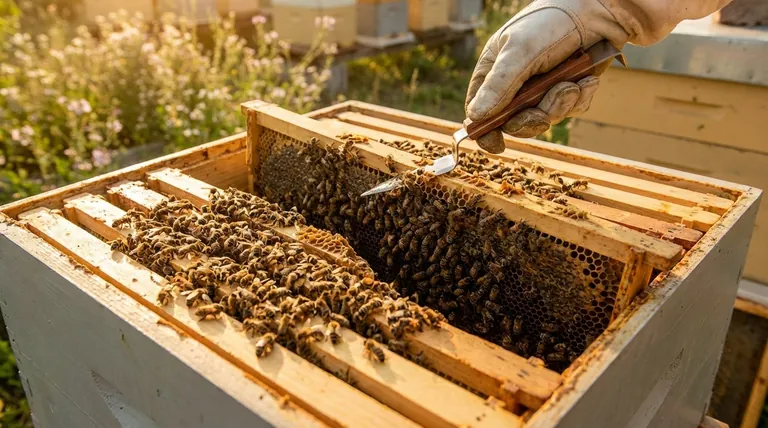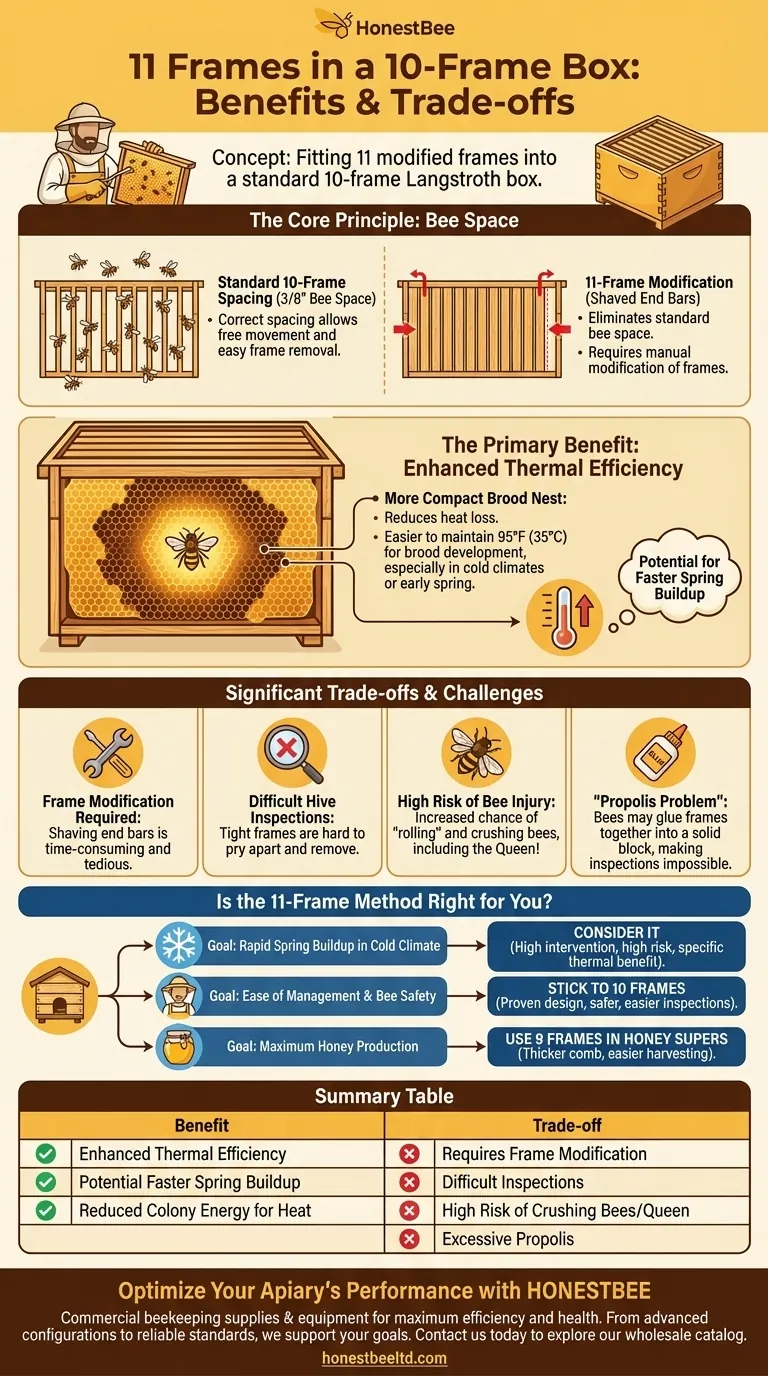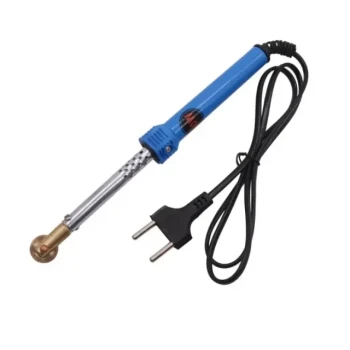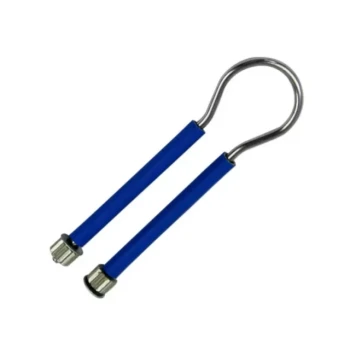The primary benefit of using 11 frames in a 10-frame beehive box is to create a more compact brood nest. By reducing the space between frames, the bee cluster can more easily and efficiently regulate the temperature of the developing brood, which is particularly advantageous in colder climates or during early spring buildup. This, however, requires physically modifying the frames to fit and introduces significant management challenges.
This technique is a specialized manipulation focused entirely on thermal efficiency for the brood nest. It is not a standard practice because the benefits of a tighter cluster are often outweighed by the increased difficulty of hive inspections and the higher risk of harming your bees.

The Core Principle: Altering Bee Space
To understand the 11-frame method, you first need to understand the concept of "bee space," the foundational principle of modern beekeeping.
Standard 10-Frame Spacing
A standard 10-frame Langstroth box is designed to give bees a specific amount of space—typically 3/8 of an inch (about 9.5mm)—between the surfaces of each frame of honeycomb.
This precise gap, known as bee space, is large enough for bees to move freely but small enough that they won't build unwanted "burr comb" to fill it in. This design is what makes hive inspections possible with removable frames.
How 11 Frames Change the Geometry
Forcing 11 frames into a box designed for 10 eliminates the standard bee space between them. To make this physically possible, the end bars of each frame must be shaved or cut down.
The result is a brood chamber where the comb surfaces are much closer together. Bees can still navigate the tighter space, but the overall structure of the brood nest becomes far more dense.
The Primary Benefit: Enhanced Thermal Efficiency
The sole purpose of this modification is to help the bees manage heat within the brood nest.
Why Brood Temperature is Critical
Honey bee colonies must maintain a stable temperature of around 95°F (35°C) in the brood area to ensure larvae and pupae develop correctly.
Maintaining this temperature requires significant energy, especially in colder weather or when the colony's population is small. The bees generate heat by vibrating their flight muscles, consuming honey as fuel.
A More Compact Brood Nest
By placing the frames closer together, the brood is concentrated into a smaller, denser area. This tighter configuration reduces heat loss, similar to how huddling together keeps a group of people warmer.
The colony can therefore maintain the required brood temperature with less effort and less energy expenditure.
Potential for Faster Spring Buildup
Because the colony expends less energy on thermoregulation, it can allocate more resources—namely, food and worker bee effort—to raising new bees. This can lead to a more rapid population increase in the spring, a key goal for beekeepers preparing hives for the main nectar flow.
Understanding the Significant Trade-offs
While the thermal benefit is real, this technique comes with substantial drawbacks that cause most beekeepers to avoid it.
The Labor Requirement: Modifying Frames
You cannot simply buy 11 frames and put them in a 10-frame box. Each frame must be manually altered by shaving down the wooden end bars. This is a time-consuming and tedious process.
Increased Difficulty of Hive Inspections
The lack of standard bee space makes removing frames extremely difficult. The frames are wedged tightly together, requiring more force to pry apart.
The Risk of Rolling and Crushing Bees
When you pull a tight frame out or push it back in, you are very likely to "roll" bees between the adjacent comb surfaces. This action injures and kills bees.
Most critically, it dramatically increases the risk of accidentally crushing your queen, an event that can set a colony back for weeks or even cause its collapse.
The "Propolis Problem"
Bees use a sticky resin called propolis to seal gaps and secure hive components. When frames are spaced too closely, bees will often glue the frames together with an excessive amount of propolis, effectively cementing the brood box into a solid block and making inspections nearly impossible.
Is the 11-Frame Method Right for You?
This is a high-intervention technique with a narrow use case. Before attempting it, you must weigh the single potential benefit against the very real management costs.
- If your primary focus is rapid spring buildup in a very cold climate: This method can give your colonies a thermal edge, but you must accept that inspections will be difficult and risky for the bees.
- If your primary focus is ease of management and bee safety: Stick with the standard 10-frame configuration. The proven design of bee space is the cornerstone of safe and effective beekeeping.
- If your primary focus is honey production: Do the opposite. Use 9 frames in your 10-frame honey supers to encourage the bees to draw out thicker comb, which is far easier to uncap during harvest.
Ultimately, successful beekeeping relies on choosing the right configuration for your specific goals and environment.
Summary Table:
| Benefit | Trade-off |
|---|---|
| Enhanced Thermal Efficiency for brood in cold climates/early spring | Requires Frame Modification (shaving end bars) |
| Potential for Faster Spring Buildup | Difficult Hive Inspections (frames are tight) |
| Reduces colony energy expenditure on heat | High Risk of Crushing Bees/Queen during inspections |
| Excessive Propolis can glue frames together |
Optimize Your Apiary's Performance with HONESTBEE
As a commercial beekeeper or distributor, achieving maximum colony health and efficiency is paramount. The specialized technique of using 11 frames highlights the importance of precise equipment for specific beekeeping goals.
At HONESTBEE, we supply high-quality, durable beekeeping supplies and equipment designed to meet the rigorous demands of commercial apiaries and distributors. Whether you're experimenting with advanced hive configurations or need reliable standard equipment, our wholesale-focused operations ensure you get the right tools for success.
Let's discuss how our products can support your operation's unique needs. Contact our expert team today to explore our wholesale catalog and enhance your beekeeping efficiency.
Visual Guide

Related Products
- HONESTBEE Premium Italian Style Hive Tool with Hardwood Handle
- Professional Stainless Steel Pry-Bar Hive Tool
- Multi-Function Plier-Style Frame Grip Hive Tool
- HONESTBEE Advanced Ergonomic Stainless Steel Hive Tool for Beekeeping
- HONESTBEE 15-in-1 Beekeeper Multi-Tool with Hammer and Pliers for Beekeeping
People Also Ask
- Is it advisable to manage a large number of hives alone? The Risks of Solo Beekeeping at Scale
- What is the hive tool used for? The Essential Multi-Tool for Every Beekeeper
- What is a hive tool and why is it important in beekeeping? The Essential Key to Hive Management
- What maintenance steps are recommended for hive tools? Ensure Longevity & Apiary Health
- What is required for regular inspections in both Flow Hives and Langstroth hives? Essential Beekeeping Tasks Explained



















